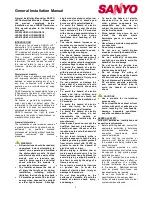
General Installation Manual
3
PV-modules are defined as follows:
Class A: General access, hazardous
voltage, hazardous power applications
Module rated for use in this application
class may be used in systems operating at
greater than 50 V DC or 240 W, where
general contact access is anticipated.
Modules qualified for safety through this
part of IEC 61730-1 and IEC 61730-2 and
within
this
application
class
are
considered to meet the requirements for
safety class II.
Fire class of product
Sanyo HIT PV modules fill the fire class C
that provides to ANSI/UL790. Class C roof
coverings are effective against light fire
test exposures. Under such exposures,
roof coverings of this class afford a light
degree of fire protection to the roof deck,
do not slip from position, and are not
expected to produce flying brands.
Mechanical Loading
•
The modules should be mounted at
the four (4) quarter points by the
means shown in Figures 3-1, 3-2, 3-3.
•
This method offers a maximum load
of 2400N/m2 (50PSF, in a static
state) on the module surface.
CERTIFICATION
The HIP-xxxHDE1, xxxHDE1-2 Modules
comply
with
the
requirements
of
IEC61730-1, IEC61730-2 and the CE
mark.
WIRING
General
•
All
wiring
should
be done
in
accordance with applicable electrical
codes.
•
All wiring should be done by a
qualified, licensed professional.
•
Wiring should be protected to help
ensure personal safety and to prevent
its damage.
•
All modules connected in series
should be of the same model number
and/or type.
•
Do not connect modules in parallel
without using a connection box.
•
Do not disconnect terminals while PV
modules generate electricity and
connect electrical load to avoid the
hazard of electrical shock.
•
To avoid the hazard of electric shock
and sparks, please connect each
cable after confirming the polarity of
them is correct.
Module Wiring
•
The maximum number of modules
that can be wired in series is twenty-
one (21).
•
Modules shall not be wired in parallel
without
maximum
over
current
protection.
•
SANYO solar modules are not
designed for “off-grid” or battery
charging systems, because of their
operating voltage. Therefore, it is not
recommended to use them to charge
batteries.
•
These
modules
contain
factory
installed bypass diodes. If these
modules are incorrectly connected to
each other, the bypass diodes, cable,
or junction box may be damaged.
Array Wiring
•
The term “array” is used to describe
the assembly of several modules on a
support structure with associated
wiring.
•
Use copper wire that is sunlight
resistant and is insulated to withstand
the maximum possible system open
circuit voltage.
•
Check
your
local
codes
for
requirements.
Earth Ground Wiring
•
The kind of the earth construction
shall conform to IEC61730-1.
•
Bonding shall be by a positive means,
such as clamping, riveting, bolted or
screwed connections, or welding,
soldering or brazing. The bonding
connections shall penetrate all non-
conductive coatings, such as paint,
anodized coatings or vitreous enamel.
•
A wiring terminal or bonding location
of module intended to accommodate
a field installed equipment-grounding
conductor shall be identified with the
appropriate symbol (IEC 60417-
5019(DB:2002-10)) or shall have a
green-colored part.
•
Grounding should be carried out by
the attachment to the module or array
frame, to avoid the hazards of electric
shock or fire.
Module Terminations
•
A junction box as a terminal
enclosure is equipped for electrical
connections on SANYO modules.
•
Modules are equipped with MC
TM
plugs as a terminal enclosure. Use
these MC
TM
plugs for electrical
connections.
•
If two or more separable connectors
are provided, they shall be configured
or arranged so that the other and
vice-versa will not accept the mating
connector for one, if it will result in an
improper connection.
•
Please
contact
your
SANYO
Authorized
Representative
with
questions regarding other electrical
connections if needed.
Junction Box and Terminals
•
Modules equipped with one junction
box contain terminals for both positive
and negative polarity, and bypass
diodes.
•
One terminal is dedicated to each
polarity (with the polarity symbols
engraved onto the body of the
junction box) (see Figure 2).
Conduit
•
For applications where wire conduits
are used, follow the applicable codes
for outdoor installation of wires in
conduits. Minimum diameter of wire
conduit is 4.0 mm
2
.
•
Verify that all fittings are properly
installed to protect wires against
damage
and
prevent
moisture
intrusion.
DIODES
Bypass Diodes
•
When the modules in series strings
are shaded partially, it may cause
reverse voltage across cells or
modules, because the current from
other cells in the same series is
forced to flow through the shaded
area. This may cause undesirable
heating to occur.
•
The use of a diode to bypass the
shaded area can minimize both
heating and array current reduction.
•
All SANYO modules are equipped
with factory installed bypass diodes.
The factory installed diodes provide
proper circuit protection for the
systems within the specified system
voltage, so that you do not need any
other additional bypass diodes.
•
Contact your SANYO Authorized
Representative for proper diode type,
if it is necessary to add or change
diodes due to system specifications.
MAINTENANCE
•
Some maintenance is recommended
to
maintain
optimal
output
performance of the solar modules.
•
If the module surface becomes dirty,
it may reduce output power.
•
It is recommended to clean the
surface of the module with water and
a soft cloth or sponge.
•
A mild non-abrasive detergent may
be applied for persistent dirt.
•
It is also recommended to inspect the
electrical and mechanical connections
annually.
•
If you need electrical or mechanical
inspection
or
maintenance,
it
is
recommended to have a licensed
authorized professional carry out the
inspection or maintenance to avoid
the hazards of electric shock or injury.
•
The return of any modules will not be
accepted by SANYO unless prior
written authorization has been given
by SANYO.
























